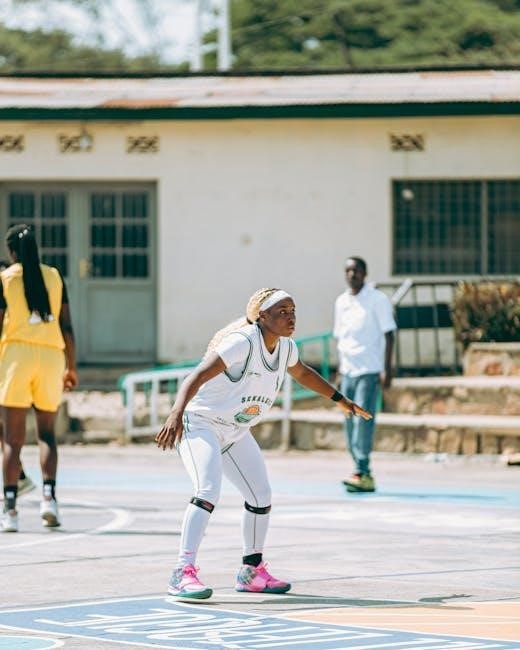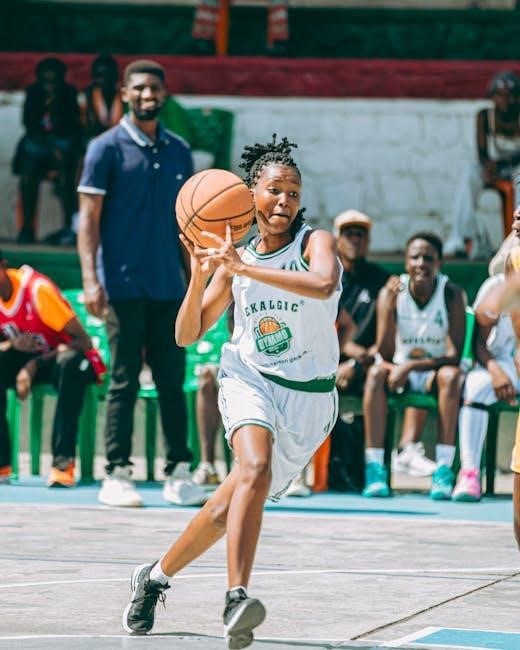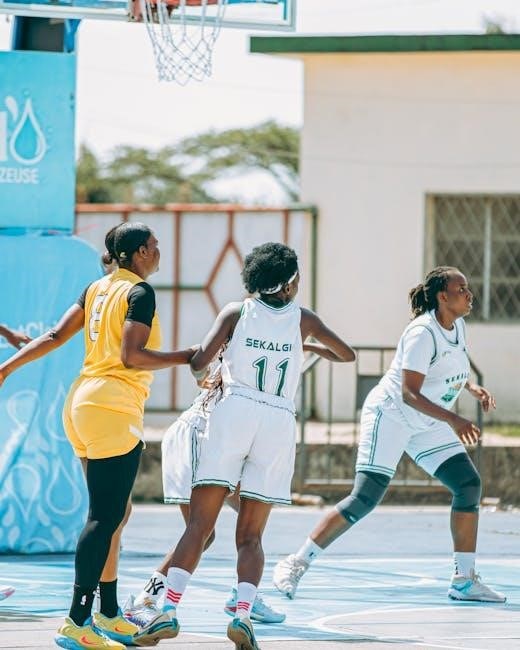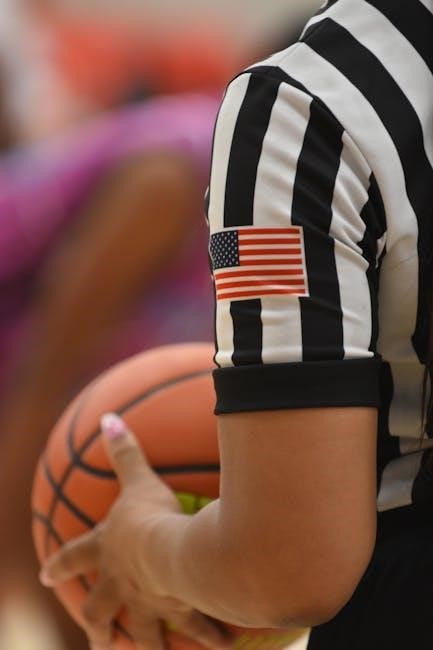Basketball rules and regulations govern gameplay, ensuring fair play and participation. Official rulebooks, like the FIBA and NBA guidelines, provide detailed frameworks for players, coaches, and referees. Available as PDFs, these documents outline game structure, scoring, fouls, and equipment standards, essential for understanding the sport.
Importance of Understanding Basketball Rules
Understanding basketball rules is essential for players, coaches, and referees to ensure fair play and player safety. Clear knowledge of regulations promotes smooth gameplay, minimizing disputes and enhancing overall performance. Rules provide a standardized framework, ensuring consistency across all levels of competition. They outline fouls, scoring methods, and game duration, which are critical for maintaining order. Ignorance of rules can lead to penalties, injuries, or game disqualifications. Coaches and players must stay updated on rule changes, like shot clock adjustments or foul limits, to strategize effectively. Referees rely on thorough rule understanding to make accurate calls. Ultimately, adherence to rules fosters sportsmanship and respect among participants, making basketball an enjoyable and competitive sport for everyone involved.

Structure of the Game
Basketball games are divided into quarters or halves, varying by league. NBA games have four 12-minute quarters, while NCAA uses two 20-minute halves. FIBA games feature four 10-minute periods. Overtime resolves tied scores, ensuring a winner.
Quarters in NBA Basketball
In NBA basketball, a game is divided into four quarters, each lasting 12 minutes. This structure ensures a balanced and fast-paced competition, allowing for strategic timeouts and player substitutions. The total game length, including breaks, typically exceeds two hours. The quarter system promotes consistent performance and exciting comebacks, as teams can recover from deficits in later periods. This format is a key aspect of the NBA’s global appeal, providing clear intervals for player rest and tactical adjustments. The 12-minute quarters are consistent across regular-season and playoff games, maintaining uniformity and fairness. This structure is distinct from NCAA and FIBA rules, which use halves or shorter periods, respectively.
Halves in NCAA Basketball

NCAA basketball games are split into two 20-minute halves, differing from the NBA’s four quarters. This format allows for a longer continuous play period, promoting endurance and strategic pacing. Each half begins with a jump ball, and the clock runs continuously except during timeouts or stoppages. Halftime provides a 15-minute break for teams to rest and adjust strategies. The 20-minute halves are a cornerstone of college basketball, fostering a unique rhythm and style of play. This structure is consistent across both men’s and women’s NCAA competitions, ensuring uniformity. The longer halves encourage teams to manage their energy and execute plays more methodically, contributing to the distinct flavor of NCAA games compared to professional leagues.
Overtime Rules
Overtime periods resolve tied games, ensuring a winner is determined. In most leagues, overtime lasts five minutes, with the first team to score a predetermined number of points (often seven in FIBA) winning. If still tied, additional periods are played until a winner emerges. The NBA uses a five-minute format, while NCAA employs a five-minute overtime for college games. FIBA also adopts a five-minute structure. Overtime begins with a jump ball, and the clock runs as in regular play. Teams must strategically manage timeouts and fouls to gain an advantage. The alternating possession arrow resets in overtime, affecting free throw alignments. Overtime rules add suspense and test teams’ endurance and decision-making under pressure.

Player and Team Regulations
Teams consist of five players on-court, with substitutions allowed during stoppages. Each player must meet eligibility criteria, including age and amateur status for certain leagues. Coaches manage rosters, ensuring compliance with rules. Teams must adhere to uniform standards and equipment regulations. Player conduct is governed by foul limits, with penalties for unsportsmanlike behavior. Substitutions and timeouts are strategically used to maintain player performance and strategy. These regulations ensure fair competition and player safety, outlined in official rulebooks like FIBA and NBA guidelines.
Team Composition and Player Eligibility
A basketball team consists of five players on the court, with a maximum of 15 players on the roster for professional leagues. Players must meet eligibility criteria, including age restrictions and amateur status for collegiate and youth levels. Substitutions are allowed during stoppages in play, with teams managing player rotations strategically. Each player must adhere to uniform and equipment standards, ensuring safety and fairness. Eligibility is verified by governing bodies, such as FIBA or the NCAA, to maintain competitive integrity. These regulations ensure fair participation and compliance with league rules, as outlined in official basketball rulebooks and guidelines.
Substitutions andTimeouts
Substitutions and Timeouts
Substitutions in basketball occur during stoppages in play, such as timeouts, free throws, or when a player commits a foul. Teams are allowed an unlimited number of substitutions, but they must be made through the designated substitution area. Timeouts are strategic stoppages called by coaches or players to discuss tactics. In professional leagues, teams are granted a set number of timeouts per game, typically varying by level, such as the NBA, NCAA, or FIBA. Proper substitution and timeout procedures ensure smooth gameplay and fair opportunities for all teams. These rules are detailed in official basketball rulebooks and guidelines, providing clarity for players, coaches, and officials.
Coaching Staff Roles and Responsibilities
Coaching staff play a pivotal role in basketball, overseeing team strategy and player development. Head coaches are responsible for designing plays, motivating players, and making tactical decisions during games. Assistant coaches support by scouting opponents, analyzing performance, and guiding specific player skills. Coaches must adhere to rules, such as timeout management and in-game conduct. They communicate with referees to clarify decisions and ensure fair play. Additionally, coaches are responsible for ensuring players understand and follow regulations. Their leadership extends beyond the court, fostering discipline and teamwork. These responsibilities are outlined in official basketball rulebooks, such as FIBA and NBA guidelines, which provide detailed frameworks for coaching staff roles and conduct.

Scoring and Timing
Basketball scoring involves points from field goals and free throws. Timing rules include shot clocks and game length variations between NBA, NCAA, and FIBA regulations.
How Points Are Scored
Points in basketball are scored through field goals, 3-pointers, and free throws. A field goal, worth 2 points, occurs when a player shoots the ball into the hoop. Three-pointers, worth 3 points, are scored when the ball is shot from behind the 3-point line. Free throws, worth 1 point each, are awarded after fouls, allowing players uncontested shots. Additionally, technical fouls can result in free throws or possession changes. The game emphasizes accuracy and strategy, with teams aiming to maximize scoring opportunities while defending against opponents. Understanding these scoring methods is essential for grasping basketball’s fundamentals and strategies.
Shot Clock Rules
The shot clock is a timer that limits the time a team has to score. In the NBA, the shot clock is 24 seconds, while in NCAA men’s basketball, it is 30 seconds, and for NCAA women’s basketball, it is 25 seconds. FIBA also uses a 24-second shot clock. When the shot clock expires, possession is awarded to the opposing team; The clock resets when the ball is rebounded or a team gains possession. The shot clock stops during timeouts, fouls, or when the ball goes out of bounds. The shot clock is designed to maintain the game’s pace and ensure offensive teams attempt to score within a reasonable time frame. Violations result in a turnover, adding strategic elements to gameplay and enhancing offensive efficiency. This rule is crucial for maintaining the flow and excitement of basketball.
Game Length Variations (NBA, NCAA, FIBA)
The length of a basketball game varies across different governing bodies. In the NBA, games are divided into four quarters, each lasting 12 minutes, totaling 48 minutes of play. The NCAA uses a two-halves format, with each half lasting 20 minutes, resulting in a 40-minute game. FIBA games also consist of four quarters, but each quarter is 10 minutes long, making the total game length 40 minutes. Overtime periods are added in case of tied scores, with each overtime period lasting 5 minutes in the NBA and NCAA, while FIBA uses a 5-minute overtime as well. These variations in game length reflect differences in pacing and strategic approaches between professional and collegiate leagues. Each format ensures competitive balance while maintaining the excitement of the game.
Live Ball and Dead Ball Situations
A live ball situation occurs when the game is in play, allowing players to score or advance the ball. This happens after a jump ball, inbound pass, or when the referee signals play to resume. A dead ball, however, stops play, often due to fouls, violations, or out-of-bounds calls. During dead ball situations, the clock halts, and players must wait for the referee’s whistle to restart play. Understanding these distinctions is crucial for players and officials to manage game flow effectively. Proper handling of live and dead ball scenarios ensures fair play and maintains the game’s rhythm, as outlined in official basketball rulebooks like those from FIBA and the NBA.

Equipment Standards
Basketball equipment must meet specific standards, including ball size, court dimensions, and player gear. FIBA and NBA regulate these to ensure consistency and safety across all games.
Ball Specifications
The basketball must meet specific size, weight, and bounce standards. FIBA and NBA regulate ball dimensions, with men’s balls larger than women’s. The ball must be made of leather or synthetic materials, ensuring consistent grip and durability. The air pressure should be maintained between 7.5 and 8.5 PSI for optimal performance. Official games require balls approved by governing bodies, ensuring fairness and consistency across all levels of play. Proper ball maintenance is essential to uphold game integrity and player safety. These specifications are detailed in official rulebooks, available as PDFs, ensuring clarity for players, coaches, and referees worldwide.
Court and Hoop Dimensions
Basketball courts vary slightly by league but follow standardized dimensions. NBA courts are 94 feet long and 50 feet wide, while NCAA courts are 94 feet by 50 feet for men and 84 feet by 50 feet for women. FIBA courts are 91.86 feet long and 49.21 feet wide. The hoop height is universally 10 feet above the floor. The three-point line distance differs: 23 feet, 9 inches in the NBA, 22 feet, 1.75 inches in NCAA for men, and 20.6 feet in FIBA. The free-throw line is 15 feet from the hoop in all leagues. These dimensions ensure consistency and fair play across all levels of competition, as detailed in official rulebooks.
Player Gear and Uniform Requirements
Player gear and uniforms in basketball must meet specific regulations to ensure safety and fairness. Jerseys and shorts are required to be matching team colors with visible numbers and player names. NBA and NCAA mandate moisture-wicking, breathable fabrics, while FIBA specifies similar standards. Shoes must be non-marking, with proper ankle support and traction. Accessories like headbands and wristbands are allowed but must be within size limits. Mouthguards are recommended but not mandatory in professional leagues. All gear must comply with league-specific guidelines, as outlined in official rulebooks. Proper attire ensures uniformity and reduces potential hazards, maintaining the integrity of the game across all levels of play.

Fouls and Violations
Fouls and violations in basketball ensure fair play and sportsmanship. Categories include personal fouls, technical fouls, and common infractions like traveling or double dribbling. Penalties range from free throws to possession changes, enforcing rule adherence and maintaining game integrity;
Personal Fouls and Limits
Personal fouls in basketball involve illegal physical contact with an opponent. Players are limited to five fouls per game in professional leagues like the NBA and FIBA. Each foul can result in free throws or possession for the opposing team. Types of personal fouls include holding, pushing, or tripping an opponent. Offensive fouls, such as charging, occur when a player initiates contact. Defensive fouls, like blocking, are called when defending players impede an opponent’s movement. Exceeding the foul limit results in disqualification, forcing the player to leave the game. Teams must strategically manage fouls to maintain player availability and competitive advantage throughout the game.
Technical Fouls and Unsportsmanlike Conduct
Technical fouls are penalties for unsportsmanlike behavior, such as arguing with referees, using inappropriate language, or taunting opponents. These fouls are intended to maintain game decorum and player respect. In professional leagues like the NBA and FIBA, technical fouls result in free throws for the opposing team. Repeated misconduct can lead to ejection from the game. Coaches and players must adhere to these rules to avoid disruptions and ensure fair play. Technical fouls are documented in official rulebooks and are strictly enforced to uphold the integrity of the sport. Understanding these guidelines is crucial for players, coaches, and fans to appreciate the game’s structure and sportsmanship expectations. Proper conduct is essential for maintaining a positive and respectful basketball environment.

Common Violations (Traveling, Double Dribble)
Traveling and double dribble are fundamental violations in basketball, enforced to maintain fair play. Traveling occurs when a player takes more than two steps without dribbling the ball. A double dribble happens when a player dribbles, then picks up the ball and dribbles again without losing possession. Both infractions result in a turnover, giving the opposing team possession. These rules ensure offensive flow and prevent unfair advantages. Proper ball handling and movement are essential for players to avoid such violations. Officials closely monitor these actions to enforce the rules effectively. Understanding these common violations helps players improve their skills and ensures a smooth game progression. Adhering to these guidelines is crucial for maintaining the integrity of basketball gameplay. These rules are detailed in official basketball rulebooks, such as the FIBA and NBA guidelines, available as PDFs for reference. Players and coaches must study these regulations to avoid penalties and enhance their performance. By following these rules, the game remains competitive and enjoyable for all participants. These violations are consistently enforced across all levels of play, from amateur to professional leagues, ensuring uniformity and fairness. Proper training and practice help minimize these errors, allowing teams to focus on strategic play. The continuous education of players and officials on these rules is vital for the sport’s development and enjoyment.
Goaltending and Basket Interference
Goaltending and basket interference are critical rules in basketball to ensure fair play. Goaltending occurs when a defensive player touches or blocks a shot that is on its downward motion toward the basket or while it is in the cylinder. This violation results in an automatic basket for the opposing team. Similarly, basket interference happens when a player touches the rim or net while the ball is in the cylinder or touches the ball to influence the game. Both infractions are enforced to maintain the integrity of scoring and prevent unfair defensive advantages. These rules are clearly defined in official basketball rulebooks, such as the FIBA and NBA guidelines, available as PDFs. Proper understanding of these regulations is essential for players, coaches, and officials to uphold the game’s fairness and competitive balance. Adhering to these rules ensures that all scoring opportunities are earned through skill and strategy rather than interference. By enforcing goaltending and basket interference rules, basketball maintains its dynamic and competitive nature, providing a balanced playing field for all participants. These regulations are consistently applied across all levels of play, from amateur leagues to professional games, ensuring uniformity and consistency in officiating. The continuous education of players and officials on these rules is vital for the sport’s development and enjoyment. These violations are strictly monitored to protect the integrity of the game and ensure a positive experience for everyone involved. The clear definitions and penalties outlined in the official rulebooks help prevent disputes and promote a smooth progression of the game. Understanding and respecting these rules is fundamental for all participants in basketball.

Recent Rule Changes
Recent basketball rule updates include the Head Coach Challenge, adjustments to foul limits, and modifications in NCAA and 3×3 basketball regulations, detailed in the latest official rulebooks.
2024 NBA Rulebook Updates
The 2024 NBA Rulebook introduces key changes to enhance gameplay and fairness. A notable update is the Head Coach Challenge, allowing coaches to request instant replay reviews on specific calls. Additionally, the last two-minute foul penalty rules have been revised, removing automatic unsportsmanlike fouls during critical moments. This change aims to reduce stoppages and improve game flow. Another significant modification is the goaltending rule, which now excludes offensive players from committing goaltending violations, promoting clearer enforcement and more scoring opportunities. These updates reflect the NBA’s commitment to modernizing the game while maintaining competitive integrity. Players, coaches, and officials must familiarize themselves with these adjustments to ensure smooth implementation during the 2024-25 season.
FIBA 2024 Official Rule Changes
The FIBA 2024 Official Rule Changes aim to enhance gameplay and clarify interpretations. Key updates include the Head Coach Challenge, allowing coaches to request an Instant Replay review for specific calls. Additionally, the last two-minute foul penalty rules have been adjusted, removing automatic unsportsmanlike fouls during the final moments of the game. Another significant change is the revision of goaltending rules, which now exclude offensive players from committing goaltending violations, simplifying enforcement and promoting scoring opportunities. FIBA also introduced new ball size regulations for youth categories to improve accessibility and skill development. These changes, effective as of October 1, 2024, are detailed in the Official Basketball Rules 2024 document, ensuring consistency across all FIBA competitions.
NCAA Basketball Rule Modifications
The NCAA introduced several rule changes to enhance gameplay and player safety. Key modifications include adjustments to offensive goaltending rules, clarifying when a ball is considered a shot or pass. Additionally, the NCAA implemented new timing regulations for in-game stoppages, reducing unnecessary delays. Coaches now have expanded challenge opportunities, allowing for more instant replay reviews. Furthermore, the NCAA emphasized player health and safety by updating protocols for head injuries and physical contact. These changes reflect the NCAA’s commitment to modernizing basketball while maintaining competitive integrity. For detailed information, refer to the 2024-25 NCAA Rulebook, which outlines all modifications and their implications for players, coaches, and officials at the collegiate level.
3×3 Basketball Rule Adaptations
FIBA’s 3×3 basketball rules offer a fast-paced, condensed version of the game. Key adaptations include a 10-minute game clock and a “first to 21 points” scoring system. The check ball procedure replaces traditional jump balls, and teams can only score from within a 7-meter half-court. Substitutions are limited, and the game emphasizes quick decision-making. FIBA introduced the two-pointer line, rewarding shots taken from beyond 5.8 meters. Overtime rules simplify tiebreakers, and fouls are managed with a 1-and-1 bonus system. These modifications enhance the dynamic nature of 3×3 basketball, making it accessible for outdoor and grassroots play. For detailed rules, refer to the FIBA 3×3 Official Rules document, available online as a PDF.

Resources and References
Access official basketball rulebooks, including FIBA, NBA, and NCAA guidelines, available as downloadable PDFs for detailed rules and updates.
Official Basketball Rulebooks (PDF)
Official basketball rulebooks are essential resources for understanding the game’s regulations. The FIBA Official Basketball Rules and the NBA Rulebook are widely recognized. These documents, available as downloadable PDFs, detail gameplay rules, fouls, and equipment standards. The FIBA Official Basketball Rules 2024 and NBA Rulebook 2024-25 include updates on scoring, timing, and player conduct. They serve as comprehensive guides for players, coaches, and referees. Additionally, the NCAA publishes its own rulebook, tailored to collegiate basketball. These PDFs are regularly updated to reflect rule changes, ensuring accuracy and compliance. They are indispensable for anyone seeking to master basketball’s rules and regulations at any level of play.
Where to Find Updated Rules and Regulations
Updated basketball rules and regulations can be accessed through official governing body websites. The FIBA and NBA websites provide downloadable PDFs of their latest rulebooks. The NCAA also offers its updated rulebook online. These resources ensure that players, coaches, and referees stay informed about rule changes. Additionally, platforms like FIBA 3×3 and regional basketball associations publish specific guidelines. Regularly checking these official sources guarantees access to the most current regulations, ensuring compliance and understanding of the game.
